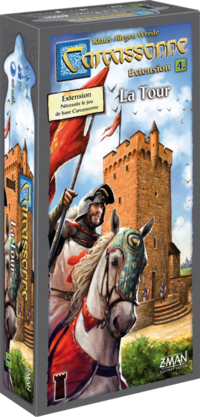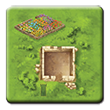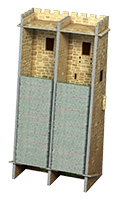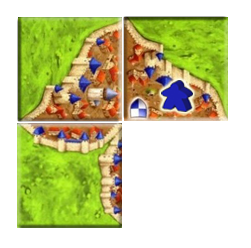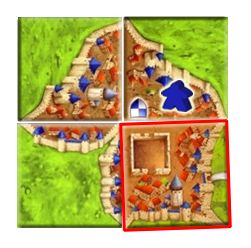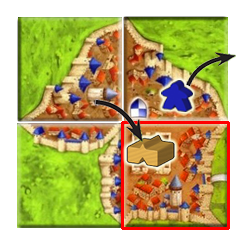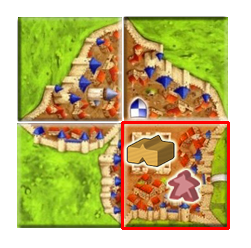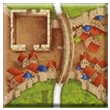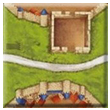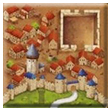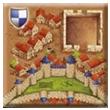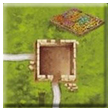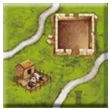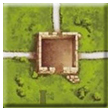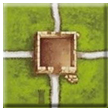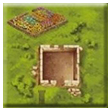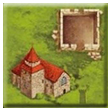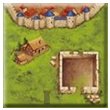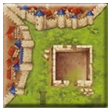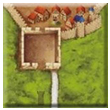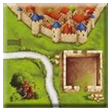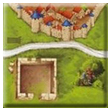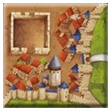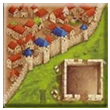La Tour
Informations générales et commentaires
La Tour a été comercialisée par Hans im Glück en Template:Year fr. La première édition a été commercialisée à l’origine en Template:Year fr. Les tuiles des premières éditions allemandes n’avaient pas de symbole d’extension.
Il s’agit de la quatrième extension majeure pour Carcassonne qui introduit un nouvel élément au jeu. Avec cette extension, vous pouvez construire de hautes tours à partir desquelles vous pouvez capturer les meeples des joueurs adverses, et les garder pour une rançon ou attendre un échange un contre un.
Les nouvelles fonctionnalités sont :
- Les tours
Une extension de Carcassonne n’est pas vraiment une extension de Carcassonne quand il n’y a pas de nouvelles tuiles, donc dans la boîte vous trouvez aussi 18 tuiles qui représentent des sections de villes, des sections de routes et des abbayes dans de nouvelles configurations plus l’ajout de fondations de tours qui aideront à créer bien plus qu’un beau paysage.
Matériel
- 18 tuiles Terrain avec une fondation de tour
- 30 étages de tour (dans une couleur neutre)
- 1 tour à tuiles comme distributeur de tuiles
Ne désassemblez pas la tour à tuiles lorsque vous rangez le jeu. Durant la partie, vous pouvez piocher les tuiles à partir du haut ou du bas de la tour. Toutefois, nous vous suggérons de piocher les tuiles à partir du haut afin d’éviter de faire tomber accidentellement les autres tuiles.
Nouvelles tuiles Terrain
Les nouvelles tuiles Terrain sont placées comme celles du jeu de base. Les fondations des tours sont le seul élément nouveau introduit sur ces tuiles. Il existe également un cas particulier, illustré ci-dessous.
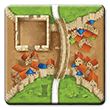 |
Cas particulier : Le pont sur cette tuile prolonge la route, mais ne sépare pas la ville. Il y a également 4 prés. |
Règles
Mise en place
Mélangez les nouvelles tuiles Terrain aux autres tuiles Terrain utilisées pour la partie, et les placer tous face vers le bas dans la tour à tuiles. Vous pouvez placer les tuiles à gauche, à droite ou dans les deux compartiments : ceci n’a aucune incidence sur la partie. Placez la tour à tuiles de façon à ce que tous les joueurs y aient facilement accès.
Ensuite, en fonction du nombre de joueurs, donnez à chaque joueur le nombre d’étages de tour correspondant :
- 2 joueurs : 10 étages
- 3 joueurs : 9 étages
- 4 joueurs : 7 étages
- 5 joueurs : 6 étages
- 6 joueurs : 5 étages
Les joueurs les placent dans leur réserve (avec leurs meeples). Remettez dans la boîte tous les étages de tour non utilisés.
La tour
1. Placement d’une tuile
Les tuiles avec des fondations de tour sont placées exactement comme celles du jeu de base.
2. Placing a meeple or a tower floor
After placing your tile, you now have 4 actions to choose from:
- You may place one of your meeples on the just-placed tile (following the normal rules).
3 new actions:
- A Place one of your tower floors on a tower foundation space on any placed tile.
- B Place one of your tower floors to any open tower on the board.
- C Place one of your meeples on any open tower. This closes the tower. [1]
POSER UN ÉTAGE DE TOUR ET CAPTURER UN MEEPLE
Whenever you place a tower floor, you may immediately take 1 meeple off the board; it can belong to any player, including yourself. The captured meeple is placed in front of you. When "capturing" your own meeple, return it to your supply.
The level where you placed your tower floor determines the tiles from which you may capture a meeple. You may always choose the tile on which you placed your tower floor. From there, for each floor in the tower, you can reach one tile in each of the 4 directions. For example, if the tower floor you placed is the first level, you have access to 5 tiles (see example below).
Placing the second level in a tower would give you access to 9 tiles from which to capture a meeple (see example below).
Consequently, each floor added to a tower extends its reach by 4 tiles (one tile in each direction). [2] This reach goes beyond empty spaces on the board and over all towers. There can be any number of floors in an open tower.
![]() Question : Can a shorter tower capture the meeple from a taller tower, or does the tower need to be equal or greater in height?
Question : Can a shorter tower capture the meeple from a taller tower, or does the tower need to be equal or greater in height?
Réponse : The height of the tower only determines the range of the ‘attack’ and has no other function.
POSER UN MEEPLE SUR UNE TOUR
When you place one of your meeples on a tower, [3] that tower is now closed and no more floors may be added to it. [4] Your meeple stays there until the end of the game (you may not take it back), or until it is captured (which you may do yourself). Players will usually take this action to protect their meeples on the board.ÉCHANGER DES PRISONNIERS
Whenever you and another player have a meeple belonging to the other, you exchange them immediately. [5] The meeples are thus returned to their respective owners. If you or the other player have more than one prisoner belonging to the other, the owner chooses which prisoner to take back.LIBÉRER DES PRISONNIERS
In addition, during your turn you may buy back one of your captured meeples. Pay the player who captured it 3 points (you reduce your score and increase theirs).
If you do not have at least 3 points, you may not buy back a meeple (this would drop your score below 0, which is not allowed). You may use a meeple in the same turn you buy it back.
Autres extensions
Many figures now exist within the world of Carcassonne, and some questions may arise when you play with The Tower expansion. Here is a list of the various figures and the actions you may and may not do with them.
- Figures you may place on a tower:
- Normal meeple, the standard option (Base game)
- Large meeple (Exp. 1 - Inns and Cathedrals)
- Ringmaster, even if is a bit wobbly (Exp. 10 - Under the Big Top)
- Phantom (The Phantom)
- Figures you may NOT place on a tower:
- Abbot (Base game - The Abbot)
- Pig (Exp. 2 - Traders and Builders)
- Builder (Exp. 2 - Traders and Builders)
- Wagon (Exp. 5 - Abbey and Mayor)
- Mayor (Exp. 5 - Abbey and Mayor)
- Barn (Exp. 5 - Abbey and Mayor)
- Shepherd (Exp. 9 - Hills & Sheep)
- Figures you may capture from the board (including your own):
- Normal meeple, the standard option (Base game)
- Abbot (Base game - The Abbot)
- Large meeple (Exp. 1 - Inns and Cathedrals)
- Meeple on a tower (Exp. 4 - The Tower)
- Wagon (Exp. 5 - Abbey and Mayor)
- Mayor (Exp. 5 - Abbey and Mayor)
- Meeple on bridge (Exp. 8 - Bridges, Castles and Bazaars)
- Ringmaster (Exp. 10 - Under the Big Top)
- Phantom (The Phantom)
- Buying back captured figures always costs 3 points, regardless of which type of figure is being bought back.
- Figures you may NOT capture from the board:
- Pig (Exp. 2 - Traders and Builders)
- Builder (Exp. 2 - Traders and Builders)
- Barn (Exp. 5 - Abbey and Mayor)
- Meeple in the city of Carcassonne (Exp. 6 - Count, King and Robber)
- Meeple in a castle (Exp. 8 - Bridges, Castles and Bazaars)
- Shepherd (Exp. 9 - Hills & Sheep)
- Meeple on a crown space of the Wheel of Fortune (The Wheel of Fortune)
- Meeple in the city of Leipzig, due to its similarity to the city of Carcassonne (The Markets of Leipzig)
- All neutral figures and tokens
- Fairy (Exp. 3 - The Princess and the Dragon)
- Dragon (Exp. 3 - The Princess and the Dragon)
- Count (Exp. 6 - Count, King and Robber)
- King marker (Exp. 6 - Count, King and Robber)
- Robber Baron marker (Exp. 6 - Count, King and Robber)
- Bridge (Exp. 8 - Bridges, Castles and Bazaars)
- Castle (Exp. 8 - Bridges, Castles and Bazaars)
- Sheep (Exp. 9 - Hills & Sheep)
- Big top (Exp. 10 - Under the Big Top)
- Animal tokens (Exp. 10 - Under the Big Top)
- Big pig on the Wheel of Fortune (The Wheel of Fortune)
- Ferries (Mini #3 - The Ferries)
- Gold ingots (Mini #4 - The Goldmines)
- Mage (Mini #5 - Mage and Witch)
- Witch (Mini #5 - Mage and Witch)
- Fruit tokens (The Fruit-Bearing Trees)
- Tollhouse tokens (The Tollkeepers)
- Little Buildings (Little Buildings)
- Outbreak tokens (Plague, The)
- Flea tokens (Plague, The)
- Teacher (The School)
- Tunnel tokens (The Tunnel)
- Exp. 2 - Traders and Builders: Prisoner buy-back only happens once in a turn, even if it a double-turn.
![]() Question : How often does prisoner buy-back occur in a “double turn” (e.g. just once, like fairy scoring, or twice, as part of a repeated step)?
Question : How often does prisoner buy-back occur in a “double turn” (e.g. just once, like fairy scoring, or twice, as part of a repeated step)?
Réponse : It happens once per turn. The double-turn is [truly] only a single turn.
- Exp. 3 - The Princess and the Dragon:
- The fairy does not protect a meeple from capture by a tower.
- The fairy can be assigned to a meeple placed on top of a tower. The fairy would stand by the tower.
- The dragon CAN eat a meeple on a tower.
- A meeple on a tower cannot be seduced by a princess, as the tower is not a part of the city; they are two separate areas.
- Exp. 8 - Bridges, Castles and Bazaars: A bridge and a tower may occupy the same tile (if necessary, move the tower slightly to make room).
- The Festival: Removal of the follower on the tower by other mechanics, such as the use of a Festival tile, is also possible. (12/2014)
- The Phantom:
- You may place your phantom on any open tower.
- You may place a valid meeple as first figure on an open tower and your phantom as second figure on a second open tower in the same turn.
- In the same turn, you may place a tower, place a tower floor (as first figure) on it, capture a meeple on an adjacent orthogonal tile (that is, range 1), and place your phantom (as second figure) on the tower tile just placed. This sequence would allow you to:
- Claim a city with your phantom after capturing the only knight in it; or
- Claim a road with your phantom after capturing the only highwayman on it.
- The following examples illustrate this sequence:
Règles non officielles
- Les tours ne peuvent pas capturer au-delà des espaces vides. (merci à viberunner)
- Un meeple capturé ne peut pas être rendu par le paiement d’une rançon (règle « œil pour œil »). (merci à keyofnight)
- Une tour d’un étage ne peut capturer qu’un meeple sur sa propre tuile. Chaque étage supplémentaire ajoute l’accès à une tuile supplémentaire dans chaque direction – l’augmentation de la portée est la même que pour les règles normales, mais le point de départ est moins puissant (règle « pas de surprises »). (merci à keyofnight)
- Une tour peut également capturer des meeples sur des tuiles en diagonale par rapport à la tuile de la tour. La distance par rapport à la tuile de capture est considérée comme le plus petit nombre de mouvements horizontaux et verticaux nécessaires pour y arriver, donc une diagonale adjacente à la tuile de la tour est considérée comme étant à 2 tuiles de distance. (merci à Yi Niu)
Ensemble des tuiles
Total des tuiles : 18
Plusieurs tuiles comportent une petite illustration. Les lettres entre parenthèses indiquent l’illustration qui se trouve sur chaque tuile :
Notes
Pour les licences et les explications des icônes, veuillez visiter la page des icônes.
- ↑
 A meeple cannot be placed on a tower foundation to prevent a tower being built. Only tower floors can be placed on tower foundations. The tower can only be blocked when it already exists.
A meeple cannot be placed on a tower foundation to prevent a tower being built. Only tower floors can be placed on tower foundations. The tower can only be blocked when it already exists.
- ↑
 In other words, the range of tiles in each direction away from the tower (not counting the tower tile itself) is equal to the number of tower pieces in the tower.
In other words, the range of tiles in each direction away from the tower (not counting the tower tile itself) is equal to the number of tower pieces in the tower.
- ↑
 Tower foundations and towers built on top are separate features from roads, cities and fields. Towers are not part of any of the features they stand on or "touch" (they are not part of a city or field touching them), so there is no interaction between them:
Tower foundations and towers built on top are separate features from roads, cities and fields. Towers are not part of any of the features they stand on or "touch" (they are not part of a city or field touching them), so there is no interaction between them:
- A meeple placed on a tower does not affect majority of the features touching the tower (roads, cities or fields), and therefore the meeple does not participate in their scoring.
- A meeple placed on a tower is not affected by actions involving the features touching the tower, such as, a princess symbol.
- ↑
 This is only true as long as the meeple remains on the tower – it is the meeple's presence on the tower that halts tower growth, not the act of placement. If the meeple is removed by the dragon or another tower, tower pieces can once again be added to the now-vacated tower. (11/2013)
This is only true as long as the meeple remains on the tower – it is the meeple's presence on the tower that halts tower growth, not the act of placement. If the meeple is removed by the dragon or another tower, tower pieces can once again be added to the now-vacated tower. (11/2013)
- ↑
 No negotiation is necessary or allowed. The exchange is automatic! - as clarified in the RGG edition of the Big Box.
No negotiation is necessary or allowed. The exchange is automatic! - as clarified in the RGG edition of the Big Box.
